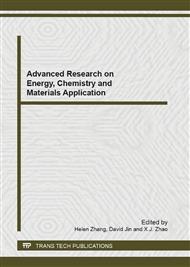[1]
K. Amine, I. Belharouak, Z. Chen, T. Tran, H. Yumoto, N. Ota, S. -T. Myung, Y. -K. Sun, adv. Mater., 22 (2010) 3052-3057.
DOI: 10.1002/adma.201000441
Google Scholar
[2]
A. Gohier, Barbara Laïk , K. -H. Kim, J. -L. Maurice, Jean-Pierre, Pereira-Ramos, C.S. Cojocaru, P.T. Van, Adv. Mater., 24 (2012) 2592-2597.
DOI: 10.1002/adma.201104923
Google Scholar
[3]
S. -H. Lee, Y. -H. Kim, R. Deshpande, P.A. Parilla, E. Whitney, D.T. Gillaspie, K.M. Jones, A.H. Mahan, S. Zhang, A.C. Dillon, Adv. Mater., 20 (2008) 3627-3632.
DOI: 10.1002/adma.200800999
Google Scholar
[4]
E. Kang, Y.S. Jung, G. -H. Kim, J. Chun, U. Wiesner, A.C. Dillon, J.K. Kim, J. Lee, Advanced Functional Materials, 21 (2011) 4349-4357.
Google Scholar
[5]
Y. Wang, G. Cao, Advanced Materials, 20 (2008) 2251-2269.
Google Scholar
[6]
M. -L. Lee, Y. -H. Li, S. -C. Liao, J. -M. Chen, J. -W. Yeh, H.C. Shih, Applied Surface Science, 258 (2012) 5938-5942.
Google Scholar
[7]
M.S. Song, A. Benayad, Y.M. Choi, K.S. Park, Chem Commun (Camb), 48 (2012) 516-518.
Google Scholar
[8]
C. Cheng, J. Wang, H. Liu, D. Zhang, L. Shi, Advanced Materials Research, 557-559 (2012) 1214-1217.
Google Scholar
[9]
X. Chen, X. Guan, L. Li, G. Li, J. Power Sources, 210 (2012) 297-302.
Google Scholar
[10]
Y. -Q. Wang, L. Gu, Y. -G. Guo, H. Li, X. -Q. He, S. Tsukimoto, Y. Ikuhara, L. -J. Wan, J. Am. Chem. Soc., 134 (2012) 7874-7879.
Google Scholar
[11]
H. Pan, L. Zhao, Y. -S. Hu, H. Li, L. Chen, ChemSusChem, 5 (2012) 526-529.
Google Scholar
[12]
R. Cai, S. Jiang, X. Yu, B. Zhao, H. Wang, Z. Shao, J. Mater. Chem., 22 (2012) 8013-8021.
Google Scholar
[13]
Z. Liu, N. Zhang, Z. Wang, K. Sun, J. Power Sources, 205 (2012) 479-482.
Google Scholar
[14]
J. Shu, L. Hou, R. Ma, M. Shui, L. Shao, D. Wang, Y. Ren, W. Zheng, RSC Adv., 2 (2012) 10306-10309.
Google Scholar
[15]
L. Shen, C. Yuan, H. Luo, X. Zhang, K. Xu, F. Zhang, J. Mater. Chem., 21 (2011) 761-767.
Google Scholar
[16]
X. Li, M. Qu, Z. Yu, Solid State Ionics, 181 (2010) 635-639.
Google Scholar
[17]
Y. Ren, A.R. Armstrong, F. Jiao, P.G. Bruce, J. Am. Chem. Soc, 132 (2010) 996-1004.
Google Scholar
[18]
G. -N. Zhu, H. -J. Liu, J. -H. Zhuang, C. -X. Wang, Y. -G. Wang, Y. -Y. Xia, Energy Environ. Sci., 4 (2011) 4016-4022.
Google Scholar
[19]
W. Wang, H. Wang, S. Wang, Y. Hu, Q. Tian, S. Jiao, J. Power Sources, 228 (2013) 244-249.
Google Scholar


